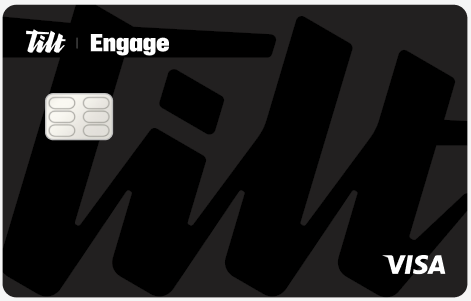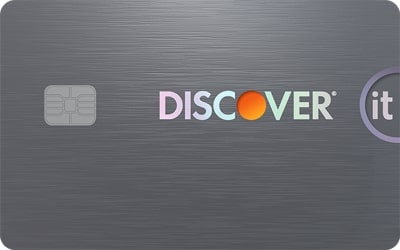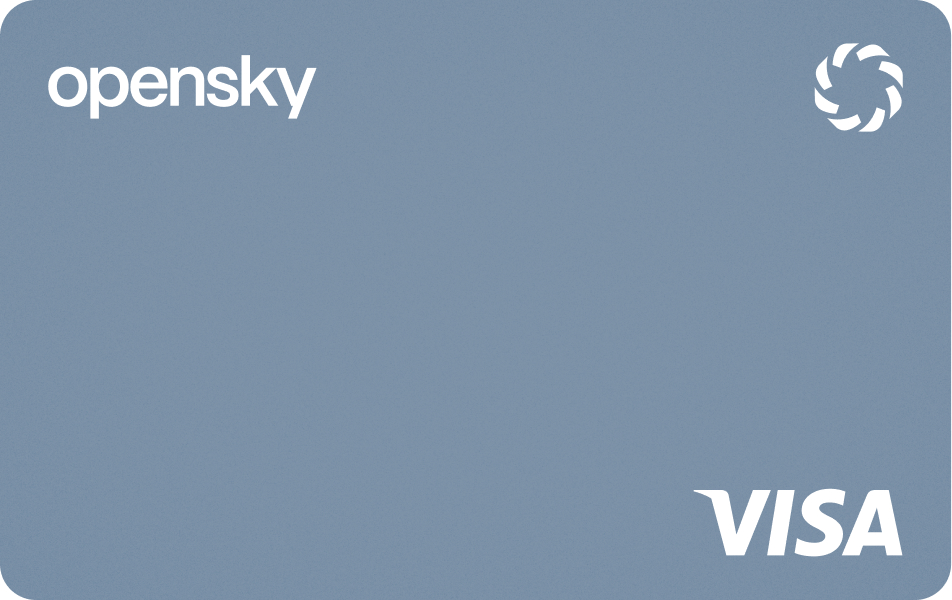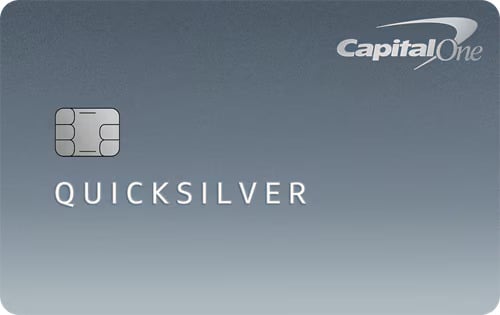Tilt Engage Review: Build Credit for a Relatively Modest Fee
The Bottom Line
2.6
The annual fee isn't outrageous compared with some other unsecured cards for bad credit, but you can likely find alternatives with no annual cost and better incentives.

Rates, fees and offers
Rates, fees and offers
Annual fee
$59
Rewards rate
1%-10%
Bonus offer
None
Intro APR
N/A
Ongoing APR
APR: 28.49%-33.49% Variable
Foreign transaction fee
0%
More details from Tilt
More details from Tilt
- 1-10% cash back at select national merchants
- See if you're pre-approved instantly without impacting your credit score. Be considered for all three Tilt cards to maximize chances of approval
- No Credit Score? No problem. Credit history isn't required for approval
- Credit limit increases in as early as 4 months for qualified borrowers
- Build credit alongside hundreds of thousands of Tilt card members
- Tilt reports to all 3 major credit bureaus
- Pay with ease with a contactless card or on your phone using Apple Pay, Google Pay, or Samsung Pay
- Zero liability fraud coverage
- Card issued by WebBank
Pros and Cons
Pros
Qualify with limited/bad credit
No foreign transaction fees
Reports to the three major credit bureaus
Cons
Annual fee
No bonus offer
No intro APR offer
Detailed Review
The Tilt Engage is an unsecured credit card meant for those with poor credit or limited cash flow, who might not have access to more conventional cards.
Issued by WebBank, its headlining feature is a unique and nontraditional underwriting process that can use income and expenses to determine applicants' eligibility, rather than relying solely on credit scores. The card reports to all three credit bureaus, plus it offers the potential to earn rewards and a path to a possible credit limit increase — features that aren't necessarily standard on other credit-builder cards.
However, unlike Tilt's other two credit cards, the Tilt Engage charges a $59 annual fee, which — in contrast to a deposit on a secured credit card — isn't refundable. It also doesn’t offer an upgrade path to a higher-tier card when you're ready, so it might not be the best long-term option.
For more information on how the three Tilt cards compare, see the table below. But here's what to know about the Tilt Engage.
Tilt — under its former company name, Empower — acquired the Petal portfolio of credit cards in 2024. Tilt's three new credit cards have replaced Petal's three cards: the Petal® 1 Rise Visa® Credit Card, the Petal® 1 Visa® Credit Card and the Petal® 2 Visa® Credit Card. Applications for those products are closed, although existing cardholders can still use them.
Tilt Engage: The basics
Card type: Starter; credit builder; bad credit.
Annual fee: $59.
Welcome bonus: None.
Rewards: 1% to 10% cash back at select merchants.
Interest rate: The ongoing APR is 28.49%-33.49% Variable.
Penalty APR: None.
Foreign transaction fees: 0%.
What to know about applying for a Tilt card
Tilt offers three possible credit cards, each targeted at different credit profiles:
The Tilt Engage (for those with poor to good credit who can't qualify for Tilt's other cards).
The Tilt Motion (for those with poor to good credit who can't qualify for Tilt's most rewarding card).
The Tilt Essentials (for those with fair to excellent credit).
You can use Tilt’s pre-qualification tool to see which of Tilt's three cards, if any, is a good fit. (You'll be considered for all three cards and will be offered terms for the one you qualify for.) Pre-qualification doesn’t have any impact on your credit scores. However, if you decide to formally apply, you must submit to a hard credit pull, which can temporarily lower your scores.
How the Tilt cards compare
| Empty Table Header | Tilt Engage | Tilt Motion | Tilt Essentials |
|---|---|---|---|
Annual fee | $59 | $0 | $0 |
Welcome bonus | None | None | None |
Rewards | 1% to 10% cash back at select merchants | 1% to 10% cash back at select merchants | 3% cash back on gas and groceries when you set up autopay; 1% back on other purchases. |
APR | The ongoing APR is 28.49%-33.49% Variable | The ongoing APR is 28.49%-33.49% Variable APR | The ongoing APR is 29.49% Variable APR |
Compare to Other Cards

Benefits and Perks
Accessibility
As noted above, applicants must go through a pre-qualification process, where they’ll be asked to provide some personal information — including Social Security number, income and housing costs — to determine which Tilt card they qualify for. This allows you to see what your odds of approval are ahead of time, before deciding to commit to a hard inquiry on your credit.
Plus, unlike conventional credit cards that usually rely on credit scores to determine your eligibility for a card, Tilt's issuer can opt to use nontraditional underwriting to determine creditworthiness. This means that when you link your bank account — which Tilt says boosts your card approval odds — factors like your income and cost of living can be used to determine your eligibility.
Comprehensive credit reporting
The Tilt Engage reports to all three major U.S. credit bureaus: Equifax, Experian and TransUnion. These bureaus compile the information that forms the basis of your credit scores — and since you never know from which bureau a potential future lender might end up pulling your credit, it's important to have a record with all of them. If you pay your balance on time and keep your credit utilization low, your credit scores could see a benefit.
Potential for credit limit increase
Tilt cardholders can increase their credit limits in any of three ways:
If you link your bank to your card account during the application process or within the first 30 days of having the card, you will get a guaranteed credit line increase.
Tilt also monitors card usage and offers eligible customers (those with positive card spending and repayment habits) a limit increase in as little as four months, according to the company.
Additionally, cardholders have the opportunity to be considered for one credit limit increase of a minimum of $50 through Tilt’s Leap program. You must make your minimum payment or 15% of your monthly statement — whichever is greater — by the payment due date for six consecutive billing cycles that you have a payment due.
You can earn rewards
When trying to build credit, earning rewards might not be a top priority. But it’s still a factor to consider, as it can make a card valuable long term.
With the Tilt Engage card, you get 1% to 10% cash back at select merchants. You can redeem cash back for statement credit only. Points don’t expire, and there’s no maximum number of points you can earn.
It travels well
Because the Tilt Engage doesn't charge foreign transaction fees, it's ideal for those traveling or studying abroad. And since the card runs on the Visa payment network, it will be accepted virtually everywhere you go.
Tilt offers three kinds of financial products: cash advances, credit cards and a line of credit. Customers are only allowed to have one of those products at a time.
Drawbacks and Considerations
Annual fee
The Tilt Engage charges a $59 annual fee, which can be a hurdle, particularly for those with poor credit scores. Initially, that annual fee is deducted from your overall credit limit. So, for example, if you get approved for a credit line of $300, you’ll have only $241 available for spending initially, until you pay the fee.
To be sure, among unsecured cards for bad credit, a $59 annual fee isn't exorbitant. And unlike some other options on the market, the Tilt Engage doesn’t come with sneaky monthly "installment" or "maintenance" fees.
Still, you can find credit cards for those with poor credit that don't charge annual fees, especially if you're willing to put down a security deposit. For instance, the $0-annual-fee Discover it® Secured Credit Card is a solid option. It reports to all three credit bureaus, earns rewards and also offers a welcome bonus for new cardholders. The card does require a minimum security deposit of $200. But keep in mind that security deposits — unlike annual fees — are refundable.
No upgrade path
Holders of the Tilt Engage can’t upgrade to another card in the Tilt portfolio, meaning that once they're ready to move to a better card, they'll have to switch to a different company and then decide whether to keep paying the $59 annual fee.
For an option that does offer an upgrade path, consider the $0-annual-fee Capital One Platinum Secured Credit Card. It requires a minimum deposit of $49, $99 or $200, depending on what you qualify for, and it doesn't earn rewards. But if you maintain good payment history, you can eventually qualify to upgrade your account to an unsecured Capital One product with better terms and features.
Limited ongoing rewards
You can earn modest rewards with the Tilt Engage card, but only if you shop with specific eligible retailers — and even then, reward rates will vary. The previously mentioned Discover it® Secured Credit Card, on the other hand, offers much broader ongoing rewards: 2% cash back at gas stations and restaurants on up to $1,000 in combined purchases each quarter. All other purchases earn 1%.
How To Decide If It's Right For You
The Tilt Engage is the only card in the Tilt portfolio that charges an annual fee, which can be a barrier for some. Still, if you have poor credit and your options are limited, the card can be a decent credit-building option.
If you can afford to pay an upfront deposit, however, a no-annual-fee secured credit card may be a better choice.
No annual fee and rewards
This card earns 1.5% cash back on all purchases. It requires a minimum security deposit of $200, but in addition to rewards, it provides a potential credit limit increase and an opportunity to upgrade to a regular unsecured credit card if you qualify.
Looking For Something Else?
Methodology
NerdWallet reviews credit cards with an eye toward both the quantitative and qualitative features of a card. Quantitative features are those that boil down to dollars and cents, such as fees, interest rates, rewards (including earning rates and redemption values) and the cash value of benefits and perks. Qualitative factors are those that affect how easy or difficult it is for a typical cardholder to get good value from the card. They include such things as the ease of application, simplicity of the rewards structure, the likelihood of using certain features, and whether a card is well-suited to everyday use or is best reserved for specific purchases. Our star ratings serve as a general gauge of how each card compares with others in its class, but star ratings are intended to be just one consideration when a consumer is choosing a credit card. Learn how NerdWallet rates credit cards.
About the author

Funto Omojola
Lead Writer & Content Strategist



